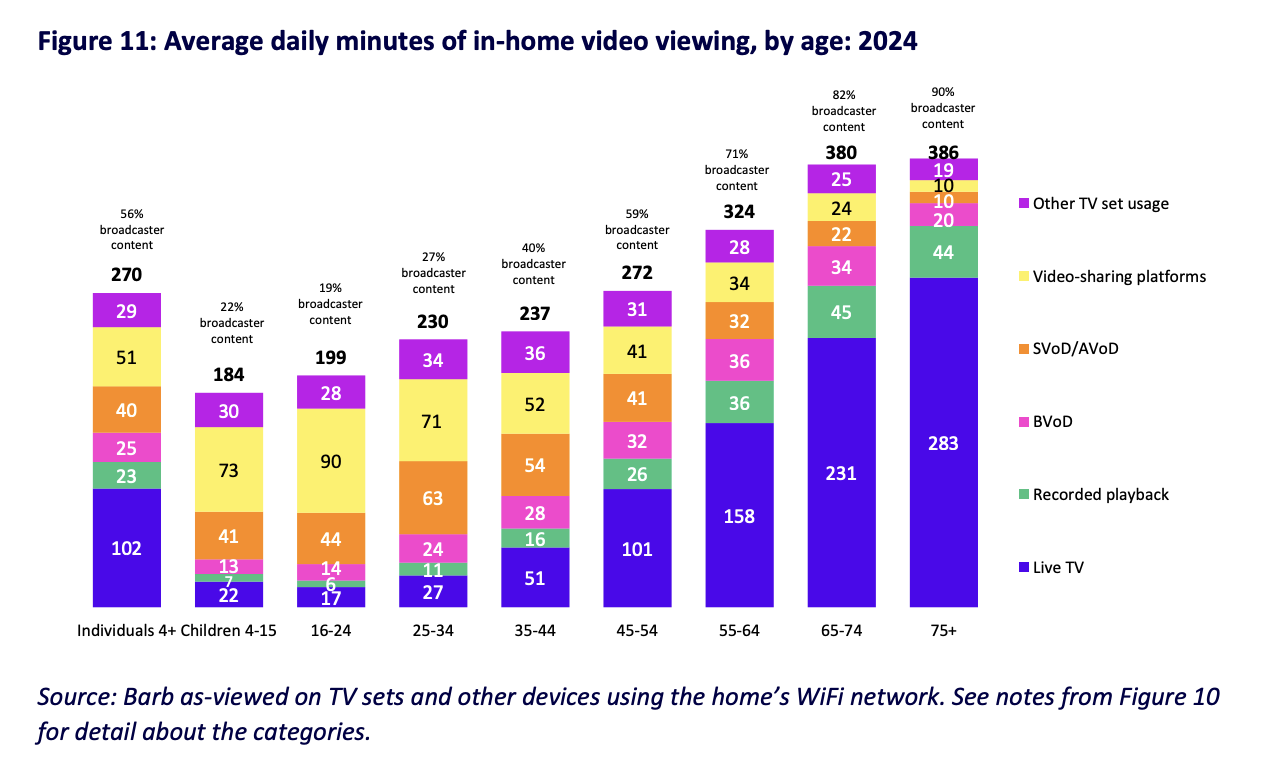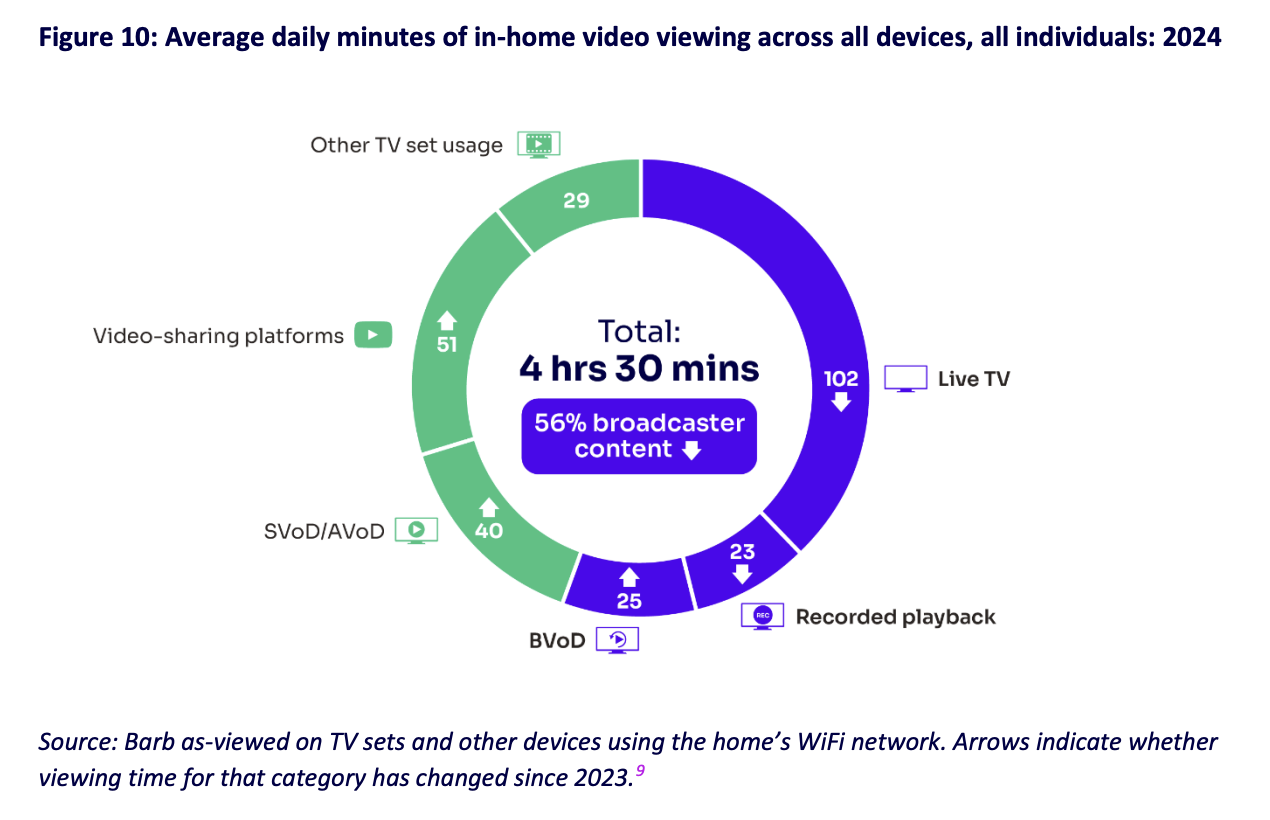What if we told you that a 75-year-old and a 25-year-old aren't just watching different programmes, they're living in completely different media universes?
This isn't hyperbole. It's the stark reality revealed in Ofcom's latest Media Nations 2025 report. A teenager spends 90 minutes every day on video-sharing platforms like YouTube, which is more time than their Grandparent spends on everything except traditional TV. Meanwhile, that same Grandparent watches nearly six hours of broadcaster content daily, living in an appointment-viewing world that feels increasingly foreign to younger generations.
Yet, beneath this generational divide lies a remarkable success story: BVOD is emerging as the standout growth area, with revenues soaring 15% year-on-year to exceed £1bn for the first time, now accounting for 25% of all broadcaster advertising revenues.
The Generational Viewing Divide: Key Statistics from 2025

The data is staggering, but the story it tells is even more profound. When a 16-24-year-old sits down to watch something, only 19% of their in-home viewing time goes to broadcaster content (live TV, recorded playback and BVOD combined), compared to 90% for those aged 75 and over. We’re not just seeing preference differences, we’re witnessing the coexistence of parallel media realities.
Consider this: a 25-34-year-old spends 63 minutes daily on subscription streaming services and 71 minutes on video-sharing platforms. That’s 134 minutes in on-demand, algorithmic environments vs. just 62 minutes with broadcaster content. They’re not rejecting traditional TV; they’re simply living in a different media ecosystem where Netflix and YouTube compete for attention in ways that BBC One and ITV1 never had to.
Perhaps nowhere is the divide more visible than in how people start their viewing sessions. When children turn on the TV, YouTube is their most popular first stop, accounting for 20.4% of all TV journeys for 4-15-year-olds. Netflix follows close behind at 18.5%. But as for traditional channels, BBC One only captures the attention of 5%.

The Empathy Challenge for Brand
At Carat, we've always believed in putting people at the centre of everything we do. But these findings force us to confront an uncomfortable truth: most strategies still assume a shared viewing experience that simply doesn’t exist.
Think about what this means for a brand trying to reach families. The parents might discover your campaign during their 51 minutes of daily live TV viewing, while their teenage child may come across it during their 90-minute YouTube session. The Grandparents, however, may see it during appointment viewing of their 283 minutes of live TV. The same campaign, but in completely different media worlds.
The BVOD Opportunity for Brands
The growth in BVOD isn’t just about audience migration; it’s about advertising effectiveness. Unlike the cluttered social media environment, BVOD offers premium, brand-safe content with sophisticated targeting capabilities. Crucially, BVOD viewing is largely complementary rather than cannibalistic to traditional TV, meaning brands can genuinely extend their reach rather than shift it.

The numbers tell a compelling story: for the first time since 2024, time spent watching BVOD (25 minutes per person per day) exceeded recorded playback viewing (23 minutes).
Designing for Different Universes
The opportunity – and the challenge – is designing experiences that work natively within each generation’s media ecosystem. When we say “TV advertising” today, we might mean linear 30-second spots for 55+ audiences, connected TV campaigns for transitional generations, YouTube brand partnerships for digital natives or smart speaker audio integration across all groups.
Consider the 25-34 demographic. They spend more time on video-sharing platforms (71 minutes) than many people spend eating meals. They’re the peak streaming generation, consuming 63 minutes of SVOD/AVOD content daily. Yet they still engage with 62 minutes of broadcaster content. They’re genuinely living in multiple media worlds simultaneously.
This generation doesn’t just watch differently, they discover differently. While 28.3% of 55+ viewers start their viewing with BBC One, 25-34s are just as likely to begin with Netflix or YouTube as they are with any traditional channel.
Yet, despite these disparate viewing behaviours, our audience’s lived experience is that these environments are all just TV to them. Hence, taking a ‘Total TV’ approach that captures viewing in all its forms neutrally, cross-platform is critical to driving impactful and effective AV media campaigns – unpinned by unified audience segmentations and measurement to help navigate the nuances of planning across these different environments.
The Audio Revolution is Hidden in Plain Sight
The video divide is just part of the story, though. Audio consumption reveals an equally dramatic generational split. People aged 15-34 now spend more than half of their weekly listening time with streamed music and podcasts (up from 40% in 2019) – almost double the average listener.

When a 25-year-old talks about their “audio content,” they might mean Spotify, podcasts and YouTube videos played in the background. When their parents mention audio content, they likely mean radio.
Pioneering the People-First Future
At Carat, we don’t see these divides as challenges. We see them as opportunities to get closer to the people that matter by understanding how they actually live with media. The old model assumed that everyone was reachable through the same entry points. The new model recognises that reaching the right people means designing experiences native to their media ecosystem.
We’re not just media planners, we’re experience designers for a multi-ecosystem world. The brands that win will be those that stop trying to force audiences into unified campaigns and start creating authentic experiences within each generation’s media universe.
The viewing divide is not going away; if anything, it’s accelerating. The question isn’t whether your brand will adapt to this reality, but whether you’ll pioneer solutions that bring you closer to the people who matter to your business.
Modern businesses are built in media around people. And people, it turns out, inhabit remarkably different media universes. The future belongs to brands that design experiences for people as they actually are, not as we imagine them to be.
Download the full Ofcom Media Nations 2025 report for deeper insights into changing media consumption patterns.
Photo by Nicolas J Leclercq on Unsplash

